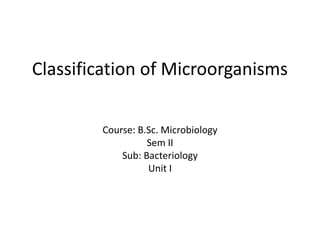
B.Sc. microbiology II Bacteriology Unit I Classification of Microorganisms
- 1. Classification of Microorganisms Course: B.Sc. Microbiology Sem II Sub: Bacteriology Unit I
- 2. Types of Classification Systems cont. • Carlolus Linnaeus proposed the Two Kingdom Classification in 1758. • The two kingdoms consisted of: – Plantae – Animalia
- 3. THREE KINGDOM SYSTEM • ERNEST HAECKEL‐1866 • KINGDOM PROTISTA: – It includes unicellular & colonial eukaryotes such as bacteria, algae, fungi & protozoans. • KINGDOM PLANTAE: – It includes multicellular photosynthetic plants. • KINGDOM ANIMALIA: – It includes multicellular animals.
- 4. Types of Classification Systems cont. • The next classification system that came about consisted of 5 kingdoms. • It was proposed by Robert Whittaker in 1969. • The 5 kingdoms consisted of: – Plantae – Animalia – Fungi – Protista – Monera
- 5. Robert Whittaker’s Five Kingdom System • Plantae – Plants are immobile, multicellular eukaryotes that produce their food by photosynthesis and have cells encased in cellulose cell walls. – Examples: Ferns, pine trees, roses • Animailia – Animals are multicellular, heterotrophic eukaryotes that are capable of mobility at some stage during their lives, and that have cells lacking cell walls. – Examples: Humans, worms, spiders
- 6. Robert Whittaker’s Five Kingdom System • Fungi – Fungi are a eukaryotic, heterotrophic, usually multicellular group having multinucleated cells enclosed in cells with cell walls. – They obtain their energy by decomposing dead and dying organisms and absorbing their nutrients from those organisms. – Examples: Mushrooms, moulds, yeast 1
- 7. • Protista • The most ancient eukaryotic kingdom, protista include a variety of eukaryotic forms. • Perhaps they are best defined as eukaryotes that are not fungi, animals, or plants. • Cell wall is usually absent, if present it is impregnated with silica (diatoms). • Photosynthetic or non photosynthetic. • Locomotory structure may be cilia, flagella, pseudopodia or absent. • Examples: Paramecium, amoeba, diatom, euglena, some algae (unicellular), slime moulds Robert Whittaker’s Five Kingdom System
- 9. Robert Whittaker’s Five Kingdom System • Monera – Monera are the only kingdom composed of prokaryotic organisms, they have a cell wall, and lack both membrane- bound organelles and multicellular forms. – Examples: Bacteria, blue-green bacteria (cyanobacteria)
- 10. Characteristics of Monera: • Unicellular or filamentous prokaryotes • Omni present (air, soil, hot springs, deserts, deep sea, snow & as parasites) • Cell wall is composed of polysaccharides & amino acids(peptido glycons ormurein) • Autotrophic (photo & chemosynthetic) & heterotrophic (saprophytic & parasitic) • Reproduce by vegetative, asexual & sexual methods
- 11. • MAJOR GROUPS OF MONERA: 1. Archaebacteria: Methanogens, Halophyles, thermoacidophyles 2. Eubacteria: Vibrio, mycobacteria 3. Cyanobacteria: Nostoc, Anabena 1 1 HalobacteriumVibrioAnabenaNostoc 6 7 8 9
- 12. Types of Classification Systems cont.. • In the 1970’s, microbiologist Carl Woese, among other researchers conducted studies and concluded that a group of prokaryotic microorganisms called archaebacteria are separate from other monerans. • Therefore, they decided to split kingdom monera into two separate kingdoms: – Eubacteria – Archaebacteria
- 13. • Archaebacteria – Unicellular – Prokaryotic – Exist in extreme environments – they do not need oxygen or light to live – Examples: methanogens, extreme thermophiles, extreme halophiles • Eubacteria – Unicellular – Prokaryotic – Heterotrophic, autotrophic, and chemotrophic – Examples: Bacteria, cyanobacteria (blue-green bacteria)
- 14. Three Domain System • The Three Domain System, developed by Carl Woese, is a system for classifying biological organisms. • Over the years, scientists have developed several systems for the classification of organisms. • From the late 1960's, organisms had been classified according to a Five Kingdom system. • This classification system model was based on principles developed by Swedish scientist Carolus Linnaeus, whose hierarchical system groups organisms based on common physical characteristics.
- 15. The Three Domain System • As scientists learn more about organisms, classification systems change. • Genetic sequencing has given researchers a whole new way of analyzing relationships between organisms. • The current system, the Three Domain System, groups organisms primarily based on differences in ribosomal RNA structure. • Ribosomal RNA is a molecular building block for ribosomes. • Under this system, organisms are classified into three domains and six kingdoms. • The domains are Archaea, Bacteria, and Eukarya. The kingdoms are Archaebacteria (ancient bacteria), Eubacteria (true bacteria), Protista, Fungi, Plantae, and Animalia. • The Archaea and Bacteria domains contain prokaryotic organisms. These are organisms that do not have a membrane bound nucleus. • Eubacteria are classified under the Bacteria domain and archaebacteria are classified as Archaeans. • The Eukarya domain includes eukaryotes, or organisms that have a membrane bound nucleus. This domain is further subdivided into the kingdoms Protista, Fungi, Plantae, and Animalia.
- 16. Comparison of Classification Systems • Five Kingdom System Kingdoms: Monera, Protista, Fungi, Plantae, and Animalia. Three Domain System • Archaea Domain – Archaebacteria Kingdom • Bacteria Domain – Eubacteria Kingdom • Eukarya Domain – Protista Kingdom – Fungi Kingdom – Plantae Kingdom – Animalia Kingdom
- 17. References Books: 1. Biology of microorganisms By M. T. Madigan, J. M. Martinko, D. A. Stahl and D. P. Clark Images: 1. https://lh4.ggpht.com/BL8zyuw37iAzWft6GzMuHTWQ7LmX1pGCKxaXjY_wF8R uMzVbHGnNAsu-XFO-r6w_ozc8hHM=s125 2. http://cfb.unh.edu/phycokey/Choices/Amoebae_Flagellates_Ciliates/Ciliates/P ARAMECIUM/Paramecium_05_600x395_caudatum.jpg 3. http://www.bodc.ac.uk/projects/uk/mfmb/introduction/images/diatoms.jpg 4. http://www.microscopy-uk.org.uk/mag/imgsep01/amoebaproteus450.jpg 5. https://lh6.ggpht.com/mkGhpDrT154r8rgB0tTM4wfgOG0- ULTlnUzmbRT7pvKbgVUoTrBC9XuJEqxTdQkEniP1jQ=s170 6. http://www.ohio.edu/plantbio/vislab/algaeimage/jpegs/nost1nitr.JPG 7. http://protist.i.hosei.ac.jp/PDB/images/Prokaryotes/Nostocaceae/Anabaena/A nabaena9c.jpg 8. https://s3.amazonaws.com/healthtap-public/ht- staging/user_answer/reference_image/8742/large/Cholera.jpeg?1344948822 9. http://plantphys.info/organismal/lechtml/images/halobacterium.jpg
